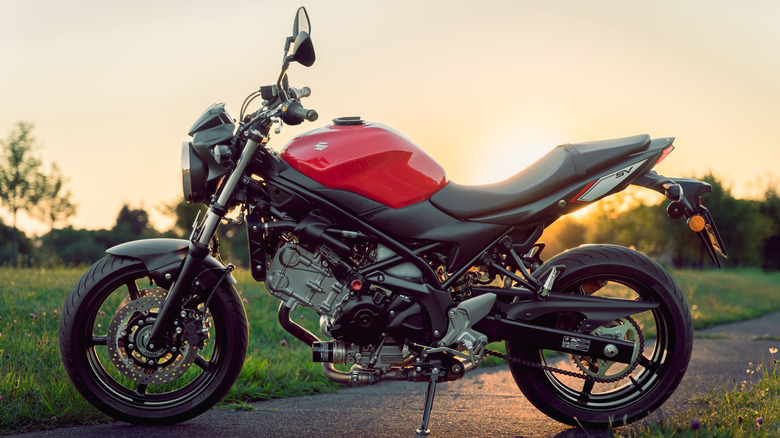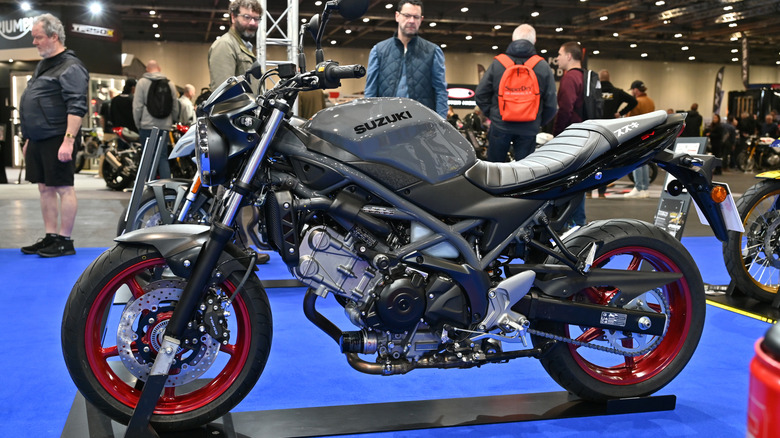Why Suzuki Is Discontinuing The SV650 In Europe (But Not The US)
The Suzuki SV650 is being dropped from the European market in 2026, but how could this happen with such a popular motorcycle? It all comes down to the continent's new Euro 5+ standards, which are an upgrade from the already strict Euro 5 law regarding emission levels. The introduction of the Euro 5+ requires motorcycles to verify long-term compliance through real-world durability tests and advanced onboard diagnostics. The purpose of the new rules is to keep bikes in the country running clean for their entire lifespan, but it also means higher costs for brands and pushes them to develop updated technology.
Motorcycle manufacturers must now install dual oxygen sensors to monitor the catalytic converter in real time, and if its efficiency drops, the bike can trigger a dashboard warning or even restrict power until it's serviced. On top of that, bikes capable of more than 130 km/h must log 35,000 km of emissions-stable testing before getting approval. For a simple, budget-friendly option like the 26-year-old SV650, retrofitting the electronics and exhaust systems to meet these requirements would require a new ECU, wiring harness, and catalyst setup. Suzuki doesn't believe the juice is worth the squeeze just to keep the old motorcycle around in Europe.
Why is the SV650 is still going strong in the U.S.
Now let's take a trip across the Atlantic to the United States, where the SV650 is one of the most popular non-Harley-Davidson motorcycles. The reason why it can remain on American roads is that U.S. regulations are way more lenient. The Environmental Protection Agency (EPA) capped motorcycle carbon monoxide output at 12,000 mg/km, roughly twelve times higher than Europe's 1,000 mg/km limit. More importantly, American rules do not require real-time catalyst monitoring or the thousands of miles of durability testing dictated by Euro 5+. The EPA's last update to its standards did not mention any upcoming changes.
Because of this, the U.S. could be viewed as a "safe haven" where Suzuki can continue selling proven but technically old models without having to worry about suddenly becoming non-compliant. The same thing happened to Suzuki before: bikes like the GSX-R600 and DR-Z400 disappeared from Europe because of earlier Euro emission rules that impacted motorcycles but stayed in the U.S. The SV650 joins that list now, being able to live in a market where regulatory pressure is more relaxed.
Changing gears toward modern successors
Suzuki hasn't said anything about abandoning the middleweight segment just yet. On the contrary, it's consolidating around the 776 cc parallel-twin engine built for its GSX-8S naked streetbike and the V-Strom 800DE adventure model. These engines were designed to comply with Euro 5+ from the beginning, including modern electronic features like ride-by-wire throttles, traction control, and quick-shifters, all coordinated by the Suzuki Intelligent Ride System (S.I.R.S.).
Instead of spending money to keep several different engines up to date, Suzuki has moved to build one new engine design that can be used on multiple bikes, saving money on development and ensuring all those bikes will pass emissions rules everywhere, now and in the future. The SV650 being discontinued in Europe marks the end of a legacy and a calculated shift in product planning. All the while, U.S. riders still benefit from the classic 645 cc twin, giving Suzuki the ability to offer value to riders in a less restrictive market.


